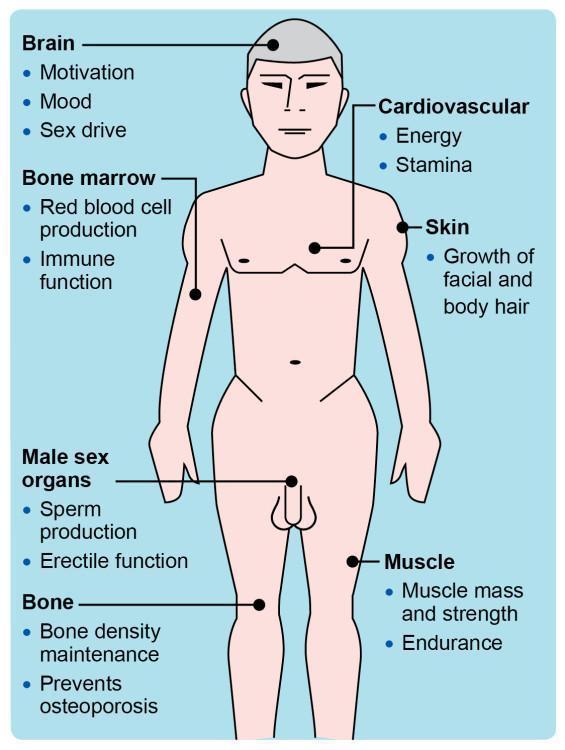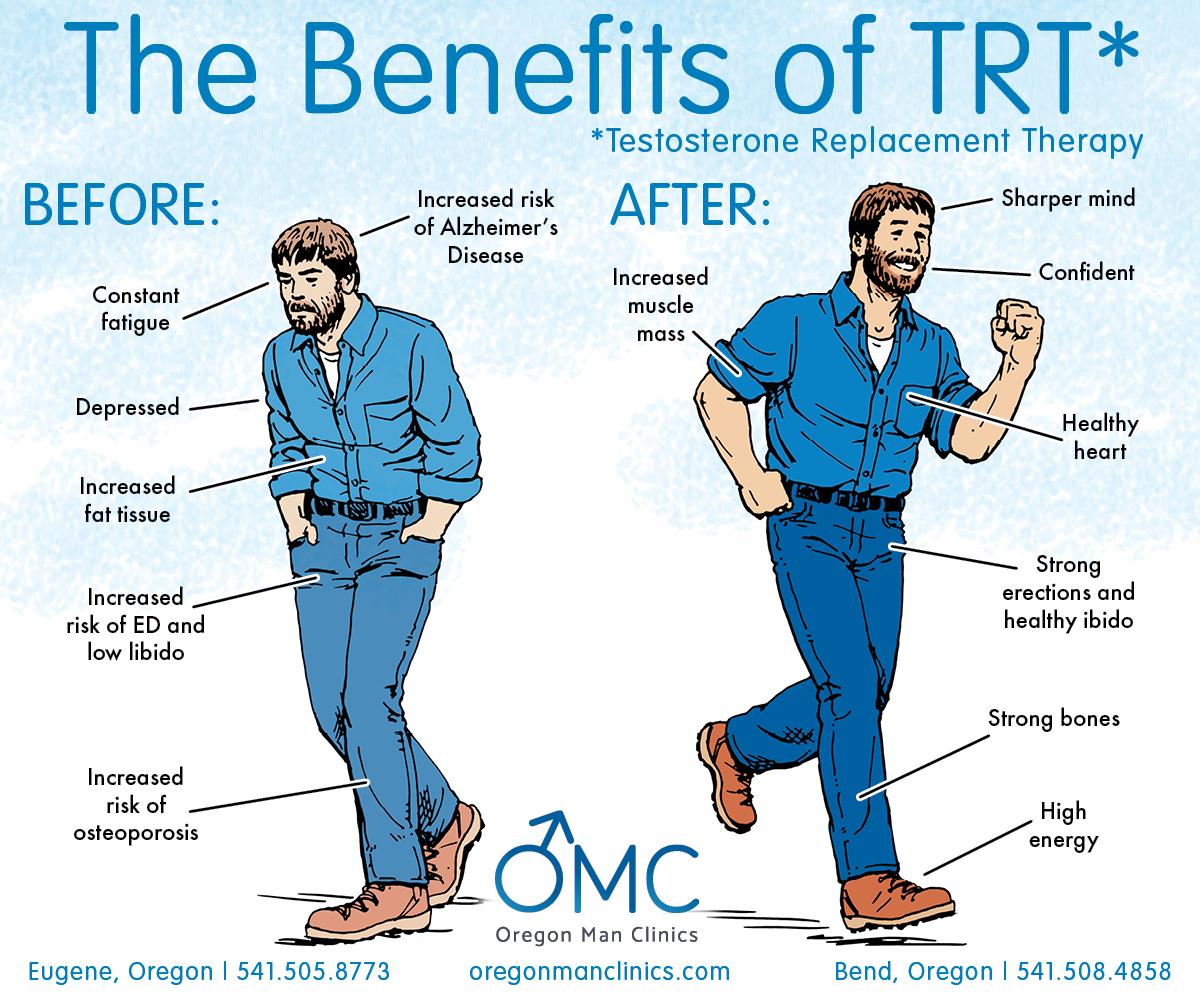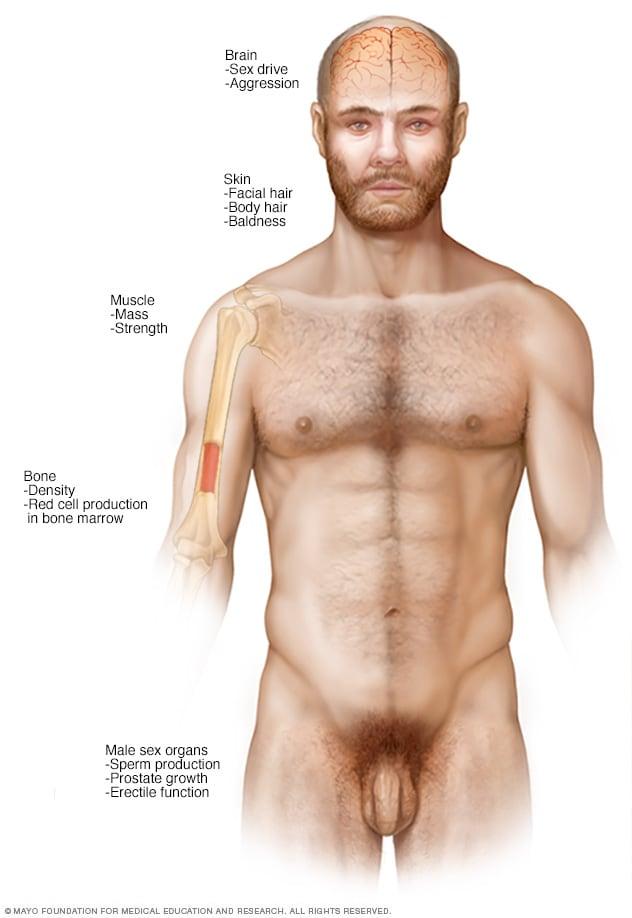In the intricate web of human biology, hormones play a crucial role, orchestrating everything from mood and energy levels to cellular repair and immune function. Among these vital players is testosterone, often recognized primarily for its influence on muscle mass and libido. However, emerging research suggests that this powerhouse hormone may also hold the key to alleviating a more surprising ailment—joint pain. For individuals grappling with the stiffness and discomfort that can accompany aging, injury, or chronic conditions, the prospect of testosterone therapy as a viable treatment option is both intriguing and potentially transformative. In this article, we will delve into the connection between testosterone levels and joint health, exploring the science behind this therapy, its potential benefits, and the considerations that accompany such an approach. Join us as we navigate the evolving landscape of hormone therapy and its role in enhancing the quality of life for those burdened by joint pain.
Understanding the Role of Testosterone in Joint Health
The significance of testosterone extends beyond its well-known roles in muscle development and libido; it also plays a pivotal part in maintaining joint health. Testosterone influences the production of synovial fluid, which lubricates joints and reduces friction during movement. This lubrication is vital for the comfort and functionality of joints, especially as individuals age or experience wear and tear. A deficiency in testosterone may lead to decreased fluid production, resulting in stiffness, pain, and potential long-term damage to cartilage. Therefore, maintaining optimal testosterone levels can be essential for preserving joint integrity and mobility.
A variety of research has highlighted the connection between testosterone levels and joint inflammation. Low testosterone is often associated with an increase in inflammatory markers, which can exacerbate conditions like arthritis. By targeting these hormonal imbalances through therapeutic measures, individuals may experience reduced inflammation, improved joint function, and overall enhancement in quality of life. Some key points regarding testosterone’s benefits for joint health include:
- Reduction of Inflammatory Response: Adequate testosterone can help lower levels of pro-inflammatory cytokines.
- Improved Bone Density: Testosterone supports healthy bone metabolism, crucial for joint stability.
- Enhanced Muscle Support: Strengthening surrounding muscles can alleviate stress on joints.
| Testosterone Benefits | Joint Health Impact |
|---|---|
| Increased Synovial Fluid | Improved lubrication and reduced friction |
| Reduced Inflammation | Alleviation of pain and swelling |
| Strengthened Muscles | Better joint support and stability |

Exploring the Connection Between Low Testosterone and Joint Pain
Low testosterone levels, often overlooked in discussions about men’s health, may play a significant role in the onset and exacerbation of joint pain. Research indicates that testosterone contributes not only to muscle strength and bone density but also to the maintenance of healthy cartilage. A deficiency in this crucial hormone can lead to inflammation and increased sensitivity in the joints, resulting in discomfort and reduced mobility. Addressing low testosterone may alleviate these symptoms and provide a more comprehensive approach to managing joint health.
Several studies have highlighted the benefits of testosterone therapy in individuals experiencing both low hormone levels and joint pain. Among the potential advantages are:
- Reduced inflammation: Testosterone may decrease inflammatory markers in the body, helping to alleviate joint swelling.
- Increased muscle strength: Enhanced muscle mass can offer better support to joints, reducing stress and strain.
- Improved quality of life: Managing pain effectively can lead to a more active lifestyle and overall well-being.
| Study | Findings |
|---|---|
| Study A | Participants noted decreased pain levels after 6 months of therapy. |
| Study B | Improvement in mobility was reported alongside hormone level normalization. |

Benefits of Testosterone Therapy for Pain Management
Testosterone therapy has emerged as a promising option for individuals suffering from joint pain, particularly when traditional treatments fall short. Administering testosterone can lead to significant benefits in the management of musculoskeletal discomfort, including:
- Reduced Inflammation: Testosterone possesses anti-inflammatory properties that may alleviate swelling in painful joints, enhancing overall comfort.
- Increased Muscle Strength: Therapy can help in building muscle mass, which is crucial for supporting and stabilizing joints, potentially minimizing pain during movement.
- Enhanced Joint Function: With improved muscle support, patients often experience increased range of motion and better joint functionality, resulting in overall quality of life improvements.
Moreover, testosterone therapy can address underlying hormonal imbalances that might contribute to chronic pain conditions. Regular administration leads to potential long-term benefits including:
- Improved Mood and Energy Levels: Testosterone influences overall well-being, which can indirectly reduce the perception of pain.
- Better Sleep Quality: Hormonal balance is linked to improved sleep patterns, facilitating recovery and pain management.
- Decreased Fatigue: Patients often report higher energy levels, which can allow increased activity, aiding in both rehabilitation and pain reduction.

Potential Risks and Considerations in Testosterone Treatment
While testosterone therapy may offer relief for joint pain, it is vital to recognize the potential risks and considerations that accompany treatment. Some individuals may experience adverse effects that can overshadow the benefits of therapy. Common concerns include:
- Cardiovascular issues: Increased risk of heart disease and stroke.
- Hormonal imbalances: Leading to mood swings and increased aggression.
- Sleep apnea: A potentially serious sleep disorder that can worsen with testosterone use.
- Skin reactions: Such as acne or oily skin.
Additionally, the appropriateness of testosterone therapy varies based on individual health profiles. Before starting treatment, it is essential to consult with a healthcare provider to consider factors such as:
| Factor | Consideration |
|---|---|
| Age | Older adults may face greater risks. |
| Pre-existing Conditions | Conditions like prostate issues may complicate therapy. |
| Medications | Interactions with other treatments must be assessed. |
Recent Studies on Testosterone Therapys Effectiveness
Recent research has shed light on the effectiveness of testosterone therapy as a potential treatment for joint pain, presenting intriguing possibilities for those suffering from chronic discomfort. In various studies, participants receiving testosterone therapy reported notable improvements in pain levels, mobility, and overall joint function. The mechanism appears to lie in the hormone’s ability to reduce inflammation and enhance tissue repair, leading to a more significant quality of life for individuals afflicted by joint-related ailments.
Key findings from the latest studies indicate that testosterone therapy might not only alleviate joint pain but also bolster muscle strength and endurance. Some of the critical insights are:
- Reduction in joint inflammation: Participants experienced decreased swelling and tenderness.
- Improved physical performance: Enhanced strength and mobility were observed post-therapy.
- Potential long-term benefits: Continued usage showed sustained improvement in joint health.
Furthermore, a comparative analysis of patient outcomes suggests that individualized treatment plans could optimize results. Below is a summary table outlining findings from a recent study:
| Study Component | Results |
|---|---|
| Participants | 150 individuals aged 40-70 |
| Duration | 24 weeks |
| Joint Pain Reduction | 60% experienced significant relief |
| Muscle Strength Increase | Average increase of 15% measured |
Integrating Testosterone Therapy with Other Pain Relief Strategies
Integrating testosterone therapy into a comprehensive pain management plan can enhance overall effectiveness while addressing joint discomfort. This multifaceted approach allows for a synergistic effect, where the hormonal benefits of testosterone can improve muscle strength, stamina, and mood, which are essential in managing chronic pain conditions. Key strategies to consider alongside testosterone therapy include:
- Physical Therapy: Tailored exercises can help improve joint function and mobility.
- Dietary Changes: Incorporating anti-inflammatory foods can reduce joint inflammation and pain.
- Alternative Therapies: Options such as acupuncture or massage can provide additional pain relief.
- Medication Management: Coordination with healthcare providers to optimize pain relief through non-opioid options can be beneficial.
By employing a holistic approach, patients may experience a more significant reduction in joint pain. Collaborative care involving healthcare professionals can ensure that both testosterone therapy and adjunct pain relief methods are effectively tailored to individual needs. Below is a simplified overview of complementary therapies:
| Complementary Therapy | Potential Benefit |
|---|---|
| Physical Therapy | Improves mobility and strength |
| Acupuncture | Reduces pain and inflammation |
| Dietary Supplements | Supports joint health |
| Mindfulness Practices | Alleviates stress and enhances well-being |
Recommendations for Patients Considering Testosterone Therapy
Before considering testosterone therapy, it’s essential for patients to have an open dialogue with their healthcare providers. Discussing your symptoms, medical history, and any ongoing medications can help tailor the therapy to your needs. Key points to cover in your discussion might include:
- Your specific joint pain symptoms – Are they persistent, intermittent, or worsening?
- Current medications – Are you taking any anti-inflammatory drugs or supplements?
- Medical history – Any history of hormone-related issues or connective tissue diseases?
- Lifestyle factors – Including diet, exercise, and stress management practices.
Additionally, understanding the potential benefits and risks of testosterone therapy is crucial in making an informed decision. While therapy may alleviate joint pain and improve overall well-being, it also comes with possible side effects. To better illustrate the benefits versus risks, consider the following table:
| Benefits | Risks |
|---|---|
| Reduction in joint pain | Increased risk of cardiovascular issues |
| Enhanced muscle strength | Potential hormonal imbalances |
| Improved mood and energy levels | Possibility of sleep apnea |
Ultimately, making the choice to pursue testosterone therapy hinges on a comprehensive assessment of how it aligns with your health goals. Keeping realistic expectations and ongoing monitoring with healthcare professionals will help ensure a beneficial experience throughout your treatment journey.
Q&A
Q&A: Testosterone Therapy for Joint Pain
Q1: What is testosterone therapy, and how does it relate to joint pain?
A1: Testosterone therapy involves the administration of testosterone, a hormone primarily produced in the testes in men and in smaller amounts in women’s ovaries and adrenal glands. While it is commonly associated with issues like hormonal imbalances or low libido, emerging research suggests that testosterone may also play a role in managing joint pain, particularly in older adults. It’s believed that testosterone can potentially help reduce inflammation and improve muscle strength, both of which can alleviate joint discomfort.
Q2: Who might benefit from testosterone therapy for joint pain?
A2: Individuals, especially men over the age of 40, experiencing symptoms of low testosterone—such as fatigue, reduced muscle mass, or decreased sexual interest—might find relief from joint pain through therapy. However, women with certain medical conditions or undergoing menopause may also experience beneficial effects. It’s crucial for anyone considering therapy to consult with a healthcare provider for an evaluation of their specific circumstances.
Q3: What are some possible benefits of testosterone therapy for joint pain relief?
A3: Several potential benefits of testosterone therapy for joint pain include enhanced lubrication of the joints, stronger surrounding muscles that support joint function, and a reduction in inflammation. Some studies indicate that maintaining optimal testosterone levels can contribute to better overall musculoskeletal health, which may lead to improved mobility and reduced discomfort in those suffering from joint-related issues.
Q4: Are there any risks associated with testosterone therapy?
A4: Yes, like any medical treatment, testosterone therapy comes with potential risks. Common side effects can include acne, sleep apnea, increased red blood cell count, and an elevated risk of blood clots. More serious concerns may involve heart health and prostate cancer. Therefore, it’s essential that therapy be managed by a medical professional who can monitor and mitigate any adverse effects.
Q5: How is testosterone therapy administered?
A5: Testosterone therapy can be administered in various forms, including injections, topical gels, patches, or pellets implanted under the skin. The method chosen often depends on individual preferences, medical history, and lifestyle. Your healthcare provider will help determine the most suitable option based on a thorough evaluation.
Q6: Is testosterone therapy a guaranteed solution for joint pain?
A6: While testosterone therapy shows promise for some individuals, it’s not a one-size-fits-all remedy. Joint pain can stem from a variety of causes, including arthritis, injury, or degenerative diseases. Thus, therapy may provide relief for some but not others. It’s essential to adopt a holistic approach to health that might include physical therapy, exercise, and diet alongside any hormonal treatment.
Q7: What should someone do if they are considering testosterone therapy for joint pain?
A7: If you’re considering testosterone therapy for joint pain, the first step is to speak with a qualified healthcare provider. They can conduct the necessary assessments, including blood tests to measure hormone levels, and discuss the potential benefits and risks tailored to your unique health profile. A comprehensive discussion will help you make an informed decision that best meets your needs.
Q8: Are there alternative treatments for joint pain if testosterone therapy isn’t an option?
A8: Absolutely. Depending on the underlying cause of joint pain, alternatives may include non-steroidal anti-inflammatory drugs (NSAIDs), corticosteroids, physical therapy, lifestyle changes, weight management, or even natural supplements like glucosamine and chondroitin. Each treatment option should be explored in consultation with a healthcare professional to determine the best approach for your specific situation.
In Retrospect
testosterone therapy emerges as a compelling avenue for those grappling with joint pain, illuminating potential pathways to relief that extend beyond traditional treatments. While research continues to explore the intricate relationship between hormones and pain perception, the anecdotal evidence and preliminary studies suggest that for some individuals, boosting testosterone levels could lead to a significant easing of discomfort. However, as with any medical intervention, it is essential to approach this option with caution, weighing the benefits against possible risks and consulting with healthcare professionals to craft a tailored strategy.
As we navigate this evolving landscape of treatment possibilities, staying informed and proactive in discussions with your medical team is key. Whether you’re seeking alternative routes to manage pain or simply curious about the latest trends in therapeutic approaches, the journey toward wellness is one that invites both exploration and wisdom. Here’s to a future where knowledge empowers choices, and every path to relief is tailored to the distinct needs of the individual.










